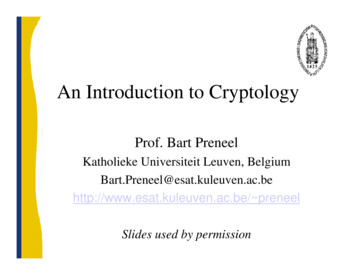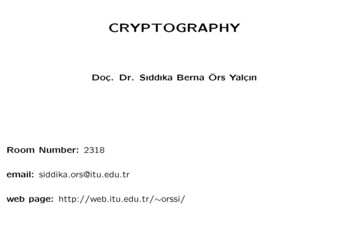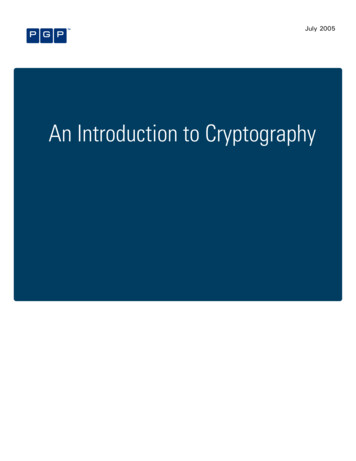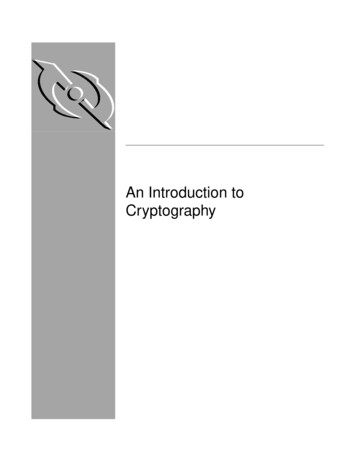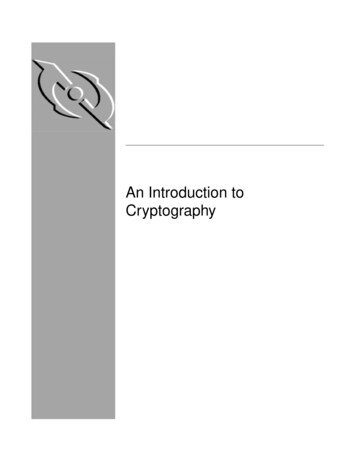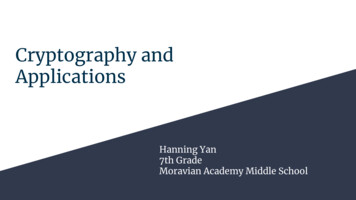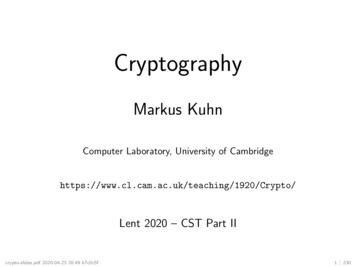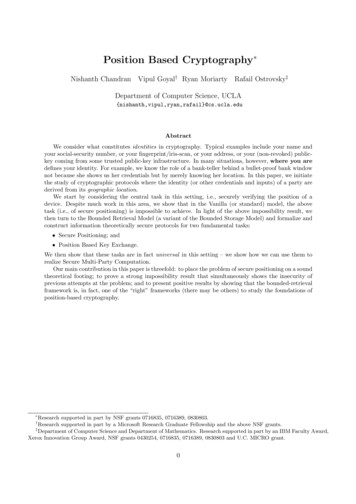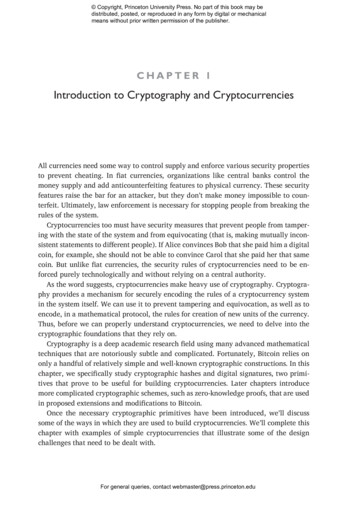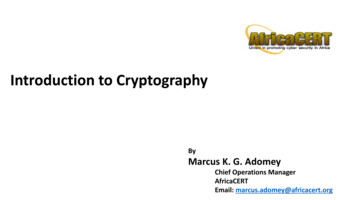
Transcription
CRYPTOGRAPHYYou may know what this means · · ·
But do you know what this means?GHIHQG WJH HDVW ZDOO RI WKH FDVWOHJulius Caesar (100 BC - 44BC) could have sent this message! Because he didn’t trusthis generals, when he sent messages he did something like replace every “A” with a“D”, every “B” with an “E”, every “C” with an “F”, etc. See the pattern? We callthis the key which allows us to decode the message. It is called the Caesar Cipher.GHIHQG WJH HDVW ZDOO RI WKH FDVWOHG H I H Q GW J HH D V WD E F E N DT H EE A S TDEFEND THE EAST WALL OF THE CASTLE
Have you downloaded an app for Cryptograms or seen a puzzle like this in a magazineor newspaper?
Goals for our study of Cryptography1. To learn basic terminology of crytography2. To see how to code and decode simple ciphers if the key is given3. To see how to decode simple substitution ciphers without a key using frequency ofletters and words4. To understand the difference between classical cryptography and modern cryptography.5. To see how Public Key Encryption works.6. To see how a Digital Signature works.
Goals for this lecture:1. See how ciphers have been used in the past.2. Learn basic terminology3. Learn how to write a message using the Caesar cipher4. Learn how to decode a message using the Caesar cipher5. To understand why this type of cipher is not secure
Atbash CipherAn even earlier code (circa 500 BC) than the Caesar cipher was used for the Hebrewalphabet. Instead of shifting a letter to the right it replaces the first letter of theHebrew alphabet (aleph) with the last letter (tav); then the second letter (beth) forthe second from last letter (shin), etc. So it uses a substitution where the letters arereflected instead of shifted.
If we used an Atbash-like cipher with our alphabet we would make a substitution likethe following.A B C D E F G H IJ K L M N O P Q R S T U V W X Y ZZ Y X W V U T S R Q P O N M L K JI H G F E D C B A
Other Early Attempts at SecrecyEarly attempts were often messy. One strategy was to hide it on the messenger. The Chinese wrote messages on silk and encased them in a ball of wax which wouldthen be hidden in the messenger. The Greeks (around 500 BC) used a different approach. Histaeus wanted to send amessage to Aristogorus to urge revolt against the Persians but he needed secrecy.He shaved the head of his most trusted slave and tattooed the message on hishead. When the hair grew back the slave was sent to Aristogorus who shaved hishead and read the message. I guess they weren’t in a hurry!
The Spartans used a tool called a scytale.A piece of parchment is wound around a baton and a message is written on it. Thenthe parchment is removed and sent to the recipient. Of course the recipient musthave the same size baton for it to work.How could you break this code?
There were no significant improvements in creating more complex ciphers until themiddle ages.Leon Battista Alberti, a Venetian, created something called a Cipher disk and describedhow to use it in a 1467 treatise. One disk is fixed and you turn the other. To makethings more difficult, the disk is rotated at multiple times during the message.You turn the disk and the letters that match up from one disk to another give thesubstitution. Note that the letters are not in order in the center disk. In this picturethe substitution V for A, Z for B, etc. is used.
Invisible InkUsing invisible ink is a less intrusive method of guaranteeing secrecy. The simplestchoices are organic compounds such as lemon juice, milk, or urine. During the American revolution both sides made extensive use of chemical inks that required specialdevelopers. It was used up through World War I.An invisible ink letter treated with a chemical reagent from British spy BenjaminThompson, 1775 (Clements Library, University of Michigan).
There is a book entitled Invisible Ink:Spycraft of the American Revolution byJohn Nagy which you might find interesting.
Encryption & Decryption We call PLAINTEXT data that can be read and understood without any specialmeasures. Examples: these notes, books, magazines, etc. ENCRYPTION is the method of disguising plaintext so that the information ishidden. CIPHERTEXT is encrypted plaintext. Example: the encrypted message on thesecond slide using the Caesar Cipher. DECRYPTION is the process of changing ciphertext to plaintext.
PLAINTEXTCIPHERTEXTENCRYPTIONPLAINTEXTDECRYPTION
What is Cryptography? Cryptography is the science and art of using methods to encrypt information. In the past, cryptography has been used to protect secrets such as military information. Now we use methods to encrypt sensitive data such as personal information andto transmit information across insecure networks so it can only be read by theintended recipient. In the far past, people used pen & pencil to encrypt messages but now mathematicalalgorithms are used. Cryptography is everywhere now.– Web traffic– Wireless traffic like BlueTooth
– Encrypting files on your computer disk– Content protection (DVDs, Blu-ray, etc.)– Digital signatures– etc. We will first look at simple encryptions methods which can be used to encrypt ordecrypt messages by hand. Then we will investigate the ideas behind sophisticated encryption methods thatare used in your daily life.Here is a quote that is worthwhile to keep in mind.“There are two kinds of cryptography in this world: cryptography thatwill stop your kid sister from reading your files and cryptography thatwill stop major governments from reading your files.”– Bruce Schneier
Codebreaking in World War IIDid you see the movie The Imitation Game or read a book about Alan Turing such asthe Enigma Machine?
After WWI the Germans built a machine called the enigma machine to protectdiplomatic and military communications. An operator typed the text of the communication on the keyboard and the machineencrypted the message. Three Polish cryptologists (working for Polish military) developed a mechanical
device for breaking the Enigma ciphers but the Germans then added additionalcomplexity to the machines to make decryption much more difficult. Crytographers during WWII (led by Alan Turing) devised an electromechanicalmachine (a forerunner of a computer) which found the key to encrypt the messagesand thus they could decrypt the messages. This played a pivotal role in reading encrypted German messages that enabled theAllies to defeat the Nazis in many crucial engagements. For more information on the Enigma machine go to cryptomuseum.com There isan app there you can download to simulate the Enigma machine.
Shifted Ciphers (Caesar Cipher) The example we showed on the first slide used the Caesar cipher where each letterof the alphabet was replaced by the letter which was three letters after it (in acircular fashion). However, we can use any number of letters between 1 and 25 to shift the letter. This means that there are only 25 possible ways to decrypt any message using thissimple shift method. Why are there 25 and not 26 ways?Shift 1 letter to rightA B C D E F G H IJ K L M N O P Q R S T U V W X Y ZB C D E F G H I J K L M N O P Q R S T U V W X Y Z A“Z” is replaced by “A” in this cipher because we shift the alphabet in a cyclic manner.
Shift 2 letters to rightA B C D E F G H IC D E F G H IJ K L M N O P Q R S T U V W X Y ZJ K L M N O P Q R S T U V W X Y Z A BShift 3 letters to rightA B C D E F G H ID E F G H IJ K L M N O P Q R S T U V W X Y ZJ K L M N O P Q R S T U V W X Y Z A B C
Example 1. Encrypt the messageGO NOLESusing a shifted cipher where you shift by 2 letters.We first write the letters of the alphabet and then under it, the letters of the alphabetshifted by two letters. Then we take “G” from the first line and see that it correspondswith “I” on the second line. The “O” on the top line corresponds with “Q” on thesecond line, etc.A B C D E F G H IC D E F G H IJ K L M N O P Q R S T U V W X Y ZJ K L M N O P Q R S T U V W X Y Z A B
Example 2. Encrypt the messageGO NOLESusing a shifted cipher where you shift by 10 letters.We first write the letters of the alphabet and then under it, the letters of the alphabetshifted by ten letters.A B C D E F G H IJ K L M N O P Q R S T U V W X Y ZK L M N O P Q R S T U V W X Y Z A B C D E F G H I J
Example 3. Encrypt the messageGO NOLESusing a shifted cipher where you shift by 13 letters.We first write the letters of the alphabet and then under it, the letters of the alphabetshifted by ten letters.A B C D E F G H IJ K L M N O P Q R S T U V W X Y ZN O P Q R S T U V W X Y Z A B C D E F G H IJ K L MNote that because we have shifted by 13 characters and our alphabet has 26 characters(2 13) it is called a symmetric cipher and given the name ROT13. This is because toencrypt and decrypt you use the same key. For example, A N and N A. ROT13is used in online forums as a means of hiding spoilers, punchlines, puzzle solutions,and offensive materials from the casual glance. It is the basis for many puzzles andgames and is thought to be the equivalent of a magazine printing the answers to a
puzzle upside down.Why did the chicken cross the road?Gb trg gb gur bgure fvqr!
Example 4. Decrypt the messageQKBXOD KXN QYVNif a shifted cipher using a shift of 10 letters to the right was used to encrypt it.We first write the letters of the alphabet and then under it, the letters of the alphabetshifted by ten letters. Now we look at the bottom line and find the letter that itcorresponds to on the top line.A B C D E F G H IJ K L M N O P Q R S T U V W X Y ZK L M N O P Q R S T U V W X Y Z A B C D E F G H I J
Class Exercises.1. Encrypt FSU using a 5 letter shift to right.2. Encrypt FSU using a 10 letter shift to right.3. Decrypt RZXNH if it was encrypted using a 5 letter shift to right.HINT for # 1 and # 3A B C D E F G H IF G H IJ K L M N O P Q R S T U V W X Y ZJ K L M N O P Q R S T U V W X Y Z A B C D E
Decrypting a Shifted CipherDecrypting a shift cipher is harder than encrypting (if we don’t know the key) becausewe have to go backwards! To encrypt all we need is to follow the key and do it oncebut with decrypting a shift cipher we have to consider possibly all choices. Lucky forus for a shifted cipher there are only 25 possibilities in English if we use a Brute-Forceapproach.Consider the encrypted message QY XYVOCIf this had been encrypted with a 1-letter shift then we write the letter before “Q”(which is “P”), then the letter before “Y” which is “X”, etc. to get PX WXUNBwhich clearly isn’t decrypted. So the message wasn’t encrypted using a 1-letter shift.If the original message was formed using a 2-letter shift then we write the letter twobefore “Q”, etc. or more simply, one letter before the 1-letter shift PX WXUNB toget OW VWUMA.Continuing in this manner, we get the following table and see that the message was
encrypted with a 10 letter shift.
A B C D E F G H I J K L M N O P Q R S T U V W X Y tShiftShift01234567891011QY XYVOCPX WXUNBOW VWUMANV UVTLZMU TUSKYLT STRJXKS RSQIWJR QRPHVIQ PQNGUHP OPMFTGO NOLESFN MNKDRWe have to do at most 25 of these shifts to find the answer. Easy for us to do andeven easier for a computer!
Because we have to do at most 25 shifts it doesn’t really matter whether we shiftbackwards or forwards. So for the previous problem we could decrypt it by shifting tothe right.QYXYVOC RZ YZWPD SAZAXQE TBABYRF UCBCZSG VDCDATH WEDEBUI XF EFCVJ YG FGDWK ZH GHEXL AI HIFYM BJ IJGZN CKJKHAO DL FNMNKDR GOKLIBP EMLMJCQNOLESIn this example it was shorter to shift backwards but this is not the case in general asthe following decryption illustrates.
Backward Shift DecryptionForward Shift Decryption0LMTK PTKL0LMTK PTKL1KLSJ OSJK1MNUL QULM2JKRI NRIJ2NOVM RVMN3IJQH MQHI3OPWN SWNO4HIPG LPGH4PQXO TXOP5GHOF KOFG5QRYP UYPQ6FGNE JNEF6RSZQ VZQR7EFMD IMDE7STAR WARS8DELC HLCD9CDKB GKBC10BCJA FJAB11ABIZ EIZA12ZAHY DHYZ13YZGX CGXY14XYFW BFWX15WXEV AEVW16VWDU ZDUV17UVCT YCTU18TUBS XBST19STAR WARS
Typically in a shift cipher the key is given as a shift to the right. So to describethe key used in this cipher, we say that we shift the alphabet 19 letters to the right.Equivalently, we could describe it as 7 letters to the left.A B C D E F G H IJ K L M N O P Q R S T U V W X Y ZT U V W X Y Z A B C D E F G H IJ K L M N O P Q R S
Example 5. We saw that with our 26 letter alphabet, then the Brute-Force approachtakes at most 25 tries to decrypt a shifted cipher. If we are using a different alphabetwhich has 31 letters, what is the maximum number of tries needed to decrypt amessage?Example 6. We saw that with our 26 letter alphabet, then the Brute-Force approachtakes at most 25 tries to decrypt a shifted cipher. If we are using a different alphabet which has 7 letters, what is the maximum number of tries needed to decrypt amessage?Example 7. How is the maximum number of tries related to the number of charactersin the alphabet?
It’s a bit tedious to go through all of these shifts every time. In fact, this is the BruteForce approach for decrypting a shifted cipher. Is there anything we can do to speedup the process?1. First we write down the alphabet across the top of a square. Then in a second rowwe write the alphabet shifted by one letter, in the third row the alphabet shiftedby 2 letters, etc. It is called a Vigenere square.2. Next we use some things we know about the English language. First, E is the mostcommon letter followed by T. Also we can take a short word and see which shiftmakes sense. We will explore more about the frequencies of letters and words inthe English language in the next lecture.3. This Vigenere square makes encrypting messages with a shifted cipher easy too.
IJKLMNOPQRSTUVWXZABCDEFGHIJKLMNOPQRSTUVWXY
Example 8. Use the fact that ”E” is the most frequently appearing letter in thealphabet and “T” the second most to decode the messageXJINODOPODJI The letter “O” appears 3 times in this expression so we first see if this represents”E”. So we look in the column with “E” at the top and go down the column untilwe see an “O”. This occurs in Shift 10 the letter “O” represents “E” and so thedecrypted message is NZ · · · which doesn’t make sense. Next we try to see if ”O” represents ”T”. We look at the column with “T” at thetop and go down the column until we find an “O”. If we look at the row beginningwith “V” we see that this is the case so we apply Shift 21 to decode the message.A B C D E F G H IJ K L M N O P Q R S T U V W X Y ZV W X Y Z A B C D E F G H IJ K L M N O P Q R S T U
IJKLMNOPQRSTUVWXZABCDEFGHIJKLMNOPQRSTUVWXY
Example 9. Use the fact that “E” is the most frequently appearing letter in thealphabet,“T” the second most and “A” the third to decode the messageIZUILQTTW The letter “I” appears 2 times in the encrypted message and the letter “T” appearstwo times (consecutive). Let’s start with “I”. We first see if “I” represents ”E”. We look at the top rowand find the column with “E” and then go down the column until we find an “I”which occurs in Shift 4 but the decryption would begin EVQEH which doesn’tmake sense. Next we try to see if ”I” represents ’“T”. If we look at the column with “T” at thetop and go down the column until we find an “I” we see that this occurs in Shift15. In this case we get TKFTW which doesn’t make sense. Next we try to see if “I” represents “A”. If we look at the column beginning with“A” we see that using Shift 8 gives a valid word.
IJKLMNOPQRSTUVWXZABCDEFGHIJKLMNOPQRSTUVWXY
Example 10. Decrypt the messageOZZ WG KSZZ The letter “Z” appears 4 times but it probably doesn’t represent an “E” (we wouldhave “EE” twice) or a “T” (we would have “?tt”) or an “A” so we have to use adifferent strategy. The first word has a double letter at the end which is probably a consonant so thefirst letter is probably a vowel. Let’s try this first. Looking at our square (see next slides with Vignere square highlighted), we nowask ourselves in which shifts does O represent a vowel. To do this we start with“O” at the top row and follow the diagonal consisting of “O” and see which shiftgives a vowel. The first encountered is “I”, then “E”, etc. We omit “O” becausethis is the unshifted alphabet and we know shift 0 doesn’t make sense.– Shift 6 O I– Shift 10 O E– Shift 14 O A
– Shift 20 O U Now we look at what “Z” represents in each of these four shifts.– Shift– Shift– Shift– Shift6 OZZ ITT10 OZZ EPP14 OZZ ALL20 OZZ UFF The only one that makes sense is Shift 14
IJKLMNOPQRSTUVWXZABCDEFGHIJKLMNOPQRSTUVWXY
Answers to Examples.Example 1. IQ PQNGUExample 2. QY XYVOCExample 3. TB ABYRFExample 4. GARNET AND GOLDExample 5. 30 triesExample 6. 6 triesExample 7. The answer is always one less than the number of letters in the alphabet.Example 8. We use a shift of 21 to get CONSTITUTION.Example 9. We use a shift 8 to get ARMADILLOExample 10. We use a shift of 14 to get ALL IS WELL
We have seen two approaches for decrypting a Shifted Cipher1. Brute Force. In this approach we try to decrypt the message by shifting the alphabetby 1 letter and if this doesn’t work we try a shift of 2 letters, etc. We know thatwe have to do at most 25 shifts to decrypt the message.2. Use our knowledge of the English language. In this approach we use commonknowledge about our language to make educated guesses for letters and see if aparticular shift gives the decoded message. A Vignere square is helpful.For a Shift Cipher it doesn’t really matter which approach we choose because theBrute Force approach only takes a maximum of 25 tries. But for other ciphers wewill see that the number of possibilities is so large that a brute force approach is notpractical.
SOCRATIVE QUIZ - Cryptography Quiz1CTISC10571.is the science and art of transforming messages to make them secure.a.b.c.d.2.is the original message before encryption.a.b.c.d.3.CryptographyAtbash CipherDecryptionCaesar CipherKeyCiphertextPlaintextNone of the aboveis the message after encryption.
a.b.c.d.KeyCiphertextPlaintextNone of the aboveis the procedure that transforms plaintext to tographyis the procedure that transforms ciphertext to phy6. In a Shift Cipher when the Key is shift to right 2 letters, how is the letter “P”decrypted?
a.b.c.d.QRST7. In a Shift Cipher when the Key is shift to right 4 letters, how is the letter “P”encrypted?a.b.c.d.RSTU8. In a Brute Force approach to decrypting a Shift Cipher where a 5 letter alphabetis used, the maximum number of tries isa.b.c.d.6543
9. If we use a Caesar shift where we shift 2 characters to the right, then “FSU” isencrypted asa.b.c.d.GTVHTVIVXHUW10. If a Caesar shift where we shift 3 characters to the right, then “ZOO” is encryptedasa.b.c.d.e.CRRYNNCPPAPPBQQ
Goals for this Lecture1. Review shifted ciphers using Vigenere square2. To understand what a monoalphabetic substitution cipher is.3. To learn how to encrypt and decrypt a message using a simple substitution cipher(other than a shifted cipher) if the key is given.4. To understand that a “Brute Force” approach to decrypting a simple substitutioncipher is not feasible.5. To learn how to interpret and make frequency plots for the occurrence of lettersand words in a given text.6. To see how to use frequency analysis to decrypt a simple substitution cipher.7. To understand the weaknesses in a monoalphabetic substitution cipher.
Last time we saw two approaches for decrypting a message that was encoded using ashifted cipher.1. Brute Force. In this approach we try to decrypt the message by shifting the alphabetby 1 letter and if this doesn’t work we try a shift of 2 letters, etc. We know thatwe have to do at most 25 shifts to decrypt a message written in English.2. Use our knowledge of the English language. In this approach we use commonknowledge about our language to make educated guesses for letters and see if aparticular shift gives the decoded message. A Vigenere square is helpful.
IJKLMNOPQRSTUVWXZABCDEFGHIJKLMNOPQRSTUVWXY
Example 1. Assuming that the message was encrypted using a shift cipher, use theVigenere square and the fact that “E” is the most frequently appearing letter in thealphabet to decode the message NYHHYMMYY. What shift was used to encode it?We note that “Y” appears 4 times so it is the most frequently occurring letter in theencoded message. We look down column 6 (with “E” at the top) and see that a shiftof 20 encodes “E” as a “Y”. Now we must see if this makes sense with the remainingletters, which it does.
Example 2. Assuming that the message was encrypted using a shift cipher, use theVigenere square and the fact that “E” is the most frequently appearing letter in thealphabet and “T” the second most to decode the message WXEXMSR . What shiftwas used to encode it?We see that “X” occurs twice and all other letters occur once. We see if “X” encodesan “E”. Looking at column 6 (with “E” at the top) we see that shift 19 works. If weuse a shift of 19 to the right then we have CELETZX which is not a word. So nowwe see if “X” encodes a “T”. Looking down the column with “T” at the top we seethat with a shift of 4 “T” is encoded as an “X”. We now try this shift and see thatit gives us a valid word.
Class Exercises1. Assuming that the message was encrypted using a shift cipher, use the Vigeneresquare and the fact that “E” is the most frequently appearing letter in the alphabetto decode the message JQJUMFSY. What shift was used to encode it?2. Assuming that the message was encrypted using a shift cipher, use the Vigeneresquare and the fact that “E” is the most frequently appearing letter in the alphabetand “T” the second most to decode the message NCYLSR ZSRRCP . What shiftwas used to encode it?
Simple Substitution Ciphers In the previous examples, the alphabet was shifted but the letters remained in thesame order. This type of cipher is the simplest type of monoalphabetic substitutioncipher which uses only one fixed alphabet. For example, when we used a Caesar Cipher with Shift 3 to right we used the singlealphabet starting with “D” as a substitution alphabetD E F G H IJ K L M N O P Q R S T U V W X Y Z A B C Also the Atbash cipher is a monoalphabetic cipher but NOT a shifted cipher. Herewe use the following alphabet as a substitution. Why is it not a shifted cipher?Z Y X W V U T S R Q P O N M L K JI H G F E D C B A
We saw that it was straightforward to decrypt a message encrypted with a shifted(monoalphabetic) key because in English we have to do at most 25 shifted versionsof the message to find the answer. We can also shorten our work by investigatingthe mostly commonly appearing letters. However, suppose we still just use the English alphabet but we mix up the order ofthe letters and then use this as a substitution. In this case decrypting the messageby doing all 25 possible shifts doesn’t work. Why? For example, we could use the keyA B C D E F G H IJ K L M N O P Q R S T U V W X Y ZF Q A M C W Z G B K T Y X D P U E I H J N R O L S V
Encrypting a message is always straightforward. For example, using the key belowA B C D E F G H IJ K L M N O P Q R S T U V W X Y ZF Q A M C W Z G B K T Y X D P U E I H J N R O L S Vthen the messageCRYTOGRAPHY IS FUNis encrypted asAISJPZIFUGS BH WND
Decrypting a message for a monoalphabetic cipher is easy if we have the key. We justtake the letter from the second line and write the corresponding letter on the upperline.Example 3. Use the key below to decrypt the messageFLNKPUBUTLMBX UJTMITMHFrom the second line we see that F is the encryption for C; L is the encryption of O,etc.A B C D E F G H IJ K L M N O P Q R S T U V W X Y ZB D F A C E H J T Z I X N M L K O V W U P G Y S Q R
Example 4. Given the Atbash key below, decrypt the message HLXIZGREV. We first find “H” on the second line (the key) and see that it represents “S” Next we find “L” on the second line and see that it represents “O”. We continue in this manner.A B C D E F G H IJ K L M N O P Q R S T U V W X Y ZZ Y X W V U T S R Q P O N M L K JI H G F E D C B A
Answers to Examples.Example 1. SHIFT 5 - ELEPHANTExample 2. SHIFT 24 - PEANUT BUTTERExample 3 COMPUTATIONAL THINKINGExample 4. SOCRATIVE
To decrypt a message without a key when a simple substitution cipher is used with theletters of the alphabet mixed up can we just use “Brute Force”, i.e., try all possibilities? Clearly we can’t try all possible combinations of the alphabet by hand but is itreasonable to write a computer algorithm which would use the Brute Force methodof trying all possible combinations as we did for the shifted encryption? The answer is NO! To see this we first look at a simplified alphabet.First assume we have an alphabet of 3 letters, A, B, C. We see that there are 3 placesto put the letter “A”AAANow in each of the three cases there are two places to put the letter “B”. For example,
when “A” is in the first position we haveABABAnd since there are 3 locations for “A” and for each location there are 2 places to put“B” we have 3 2 possibilities. Now in each of these six options there is only oneplace left for the letter “C” so we have 3 2 1 6 possibilities.Now assume we have an alphabet of 4 letters, A, B, C, D and we want to see howthe number of possible combinations increase. We see that there are 4 places to putthe letter “A”AAAA
Now in each of the four cases there are three places to put the letter “B”. For example,ABABABAnd since there are 4 locations for “A” and for each location there are 3 places to put“B” we have 4 3 possibilities. Now in each of these 12 options there are two placesleft for the letter “C”. For example,ABABCCso we have 4 3 2 24 possibilities. Finally in each of the 24 options there is onlyone place left to put the letter “D” so we get 4 3 2 1 24. The number ofpossibilities has increased by a factor of 4.Now we want to do the same thing, except when we have 26 letters in the alphabet.
First we see that there are 26 places to put the letter “A”A26 choices of where to put “A” After we have fixed the letter “A”, we fix the letter “B”. Now since “A” takes up1 placeholder there are only 25 places where we can put the letter “B”. But thereare 26 different places whe
An even earlier code (circa 500 BC) than the Caesar cipher was used for the Hebrew alphabet. Instead of shifting a letter to the right it replaces the rst letter of the Hebrew alphabet (aleph) with the last letter (tav); then the second letter (beth) for the second from last letter (shin), etc. So it uses a substitution where the letters are re

